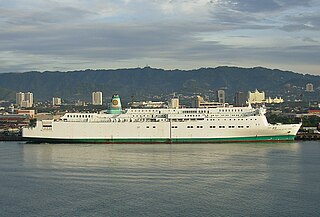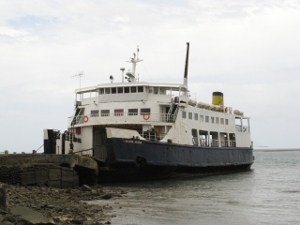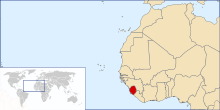
MV Le Joola was a Senegalese government-owned roll-on/roll-off ferry that capsized off the coast of The Gambia on 26 September 2002, with 1,863 deaths and 64 survivors. It is thought to be the third-worst non-military disaster in maritime history.

The MS al-Salam Boccaccio 98 was an Egyptian Ro/Ro passenger ferry, operated by El Salam Maritime Transport, that sank on 3 February 2006 in the Red Sea en route from Duba, Saudi Arabia, to Safaga in southern Egypt.

MV Princess of the Stars was a passenger ferry owned by Filipino shipping company Sulpicio Lines, that capsized and sank on June 21, 2008, off the coast of San Fernando, Romblon, at the height of Typhoon Fengshen, which passed directly over Romblon as a Category 2 storm. 814 people died.

The sinking of MV Teratai Prima occurred on 11 January 2009, around 04:00 local time when a ferry carrying more than 300 people capsized in the Makassar Strait off West Sulawesi, Survivors stated that the ferry had been slammed by 4-metre (13 ft) waves twice. The first one hit so hard that the ship became unbalanced, before another wave hit from a different direction and sank the vessel.

The MV Princess Ashika was an inter-island ferry which operated in the South Pacific kingdom of Tonga. This motorised vessel (MV) was built in 1972, and began sailing the Tongan route on 7 July 2009 only to sink less than a month later on 5 August. Official figures released by Operation Ashika on 19 August 2009, confirmed that 54 men were rescued, and 74 people were lost at sea. These include two bodies recovered and 72 missing, including five foreign nationals. Two of the missing passengers remain unidentified.
The 2009 Kiribati ferry accident was the sinking, on 13 July 2009, of an inter-island ferry in the south Pacific nation of Kiribati. The accident is believed to have killed 33 of the ship's 55 passengers and crew.

SuperFerry 9 was a ferry owned by the Philippines-based carrier Aboitiz Transport System Corp (ATSC) and operated by their SuperFerry division. About 9 a.m. Sunday, September 6, 2009, she sank off the south-west coast of Zamboanga Peninsula with a total of 971 passengers and crew aboard.
Shenge is a coastal fishing town along the Atlantic Ocean in Moyamba District, Southern Province, Sierra Leone. Shenge is the seat of the Kagboro Chiefdom, part of the third level of administration. The dense coastal jungle has prevented development of a good road network, and the Shenge is still most easily reached by boat. The local small fishing and passenger boats that travel among the coastal towns are known as pampas in Sierra Leone.
The 2010 West Bengal Ferry Sinking was an incident which occurred on Saturday, 30 October 2010, when an over-crowded ferry carrying Muslim pilgrims sank after hitting a sand bank on the Bhagirathi River in the Indian state of West Bengal. Thus far at least 74 bodies have been recovered, with many more missing, feared swept downstream.

On 10 September 2011, MV Spice Islander I, a passenger ferry carrying over 2,000 passengers, sank off the coast of Zanzibar. The ferry was travelling between Unguja and Pemba, two islands off the coast of mainland Tanzania, when it capsized. Early estimates put the death toll at around 200, but a report published by the Tanzanian government in January 2012 claimed that over 1,500 people had been killed.

MV Rabaul Queen was a passenger ferry owned by the Papua New Guinea company Rabaul Shipping. The ship, built in Japan in 1983, operated on short runs in that country, before being brought to Papua New Guinea in 1998 and plying a regular weekly route between Kimbe, the capital of West New Britain, and Lae, the capital of the mainland province of Morobe.
On 30 April 2012, a ferry carrying about 350 passengers capsized in the Brahmaputra River in the Dhubri district of Assam in Northeast India. The disaster killed at least 103 people.

The ferry MV Sewol sank on the morning of April 16, 2014, en route from Incheon towards Jeju in South Korea. The 6,825-ton vessel sent a distress signal from about 2.7 kilometres north of Byeongpungdo at 08:58 KST. Out of 476 passengers and crew, 304 died in the disaster, including around 250 students from Danwon High School in Ansan City. Of the 172 survivors, more than half were rescued by fishing boats and other commercial vessels that arrived at the scene approximately 40 minutes before the Korea Coast Guard (KCG).
MV Dongfang zhi Xing was a river cruise ship that operated in the Three Gorges region of inland China. On the night of 1 June 2015, the ship was traveling on the Yangtze River when it capsized during a thunderstorm in Jianli, Hubei Province with 454 people on board. On 13 June, 442 deaths were confirmed, with 12 survivors. The passengers were mostly in their 60s and 70s, and mostly from Nanjing, where the ship started its cruise.
MV Sinar Bangun sank on 18 June 2018 in Lake Toba, North Sumatra, Indonesia, during its trip from Simanindo Harbour in Samosir Island to Tiga Ras Harbour in Simalungun Regency. The ferry was carrying 188 passengers and crew. After the sinking, authorities immediately deployed search and rescue personnel to the area. Twenty-one survivors were rescued, three bodies were found and 164 people were listed as missing and presumed dead.

MV Nyerere is a Tanzanian ferry that capsized on 20 September 2018 while travelling between the islands of Ukerewe and Ukara on Lake Victoria. The Tanzanian government have declared that 228 people died as a result of the capsizing while 41 could be rescued. The capsized ferry was successfully righted, retrieved and unloaded more than one week after the disaster.

Hableány was a 27-metre (89 ft) river cruiser operated on the Danube river in Budapest, Hungary. On the rainy night of May 29, 2019, at 9:05 pm the 135-metre (443 ft) Viking Sigyn collided with Hableány from behind under the Margaret Bridge near the Parliament Building. Hableány sank in 7 seconds. The heavy rainfall and the resulting strong currents hampered rescue efforts, with some bodies found 100 km downstream. With 2 Hungarian crew and 33 South Korean tourists on board, 7 tourists were rescued at the scene; one person is still missing and all others were later found to be dead.











